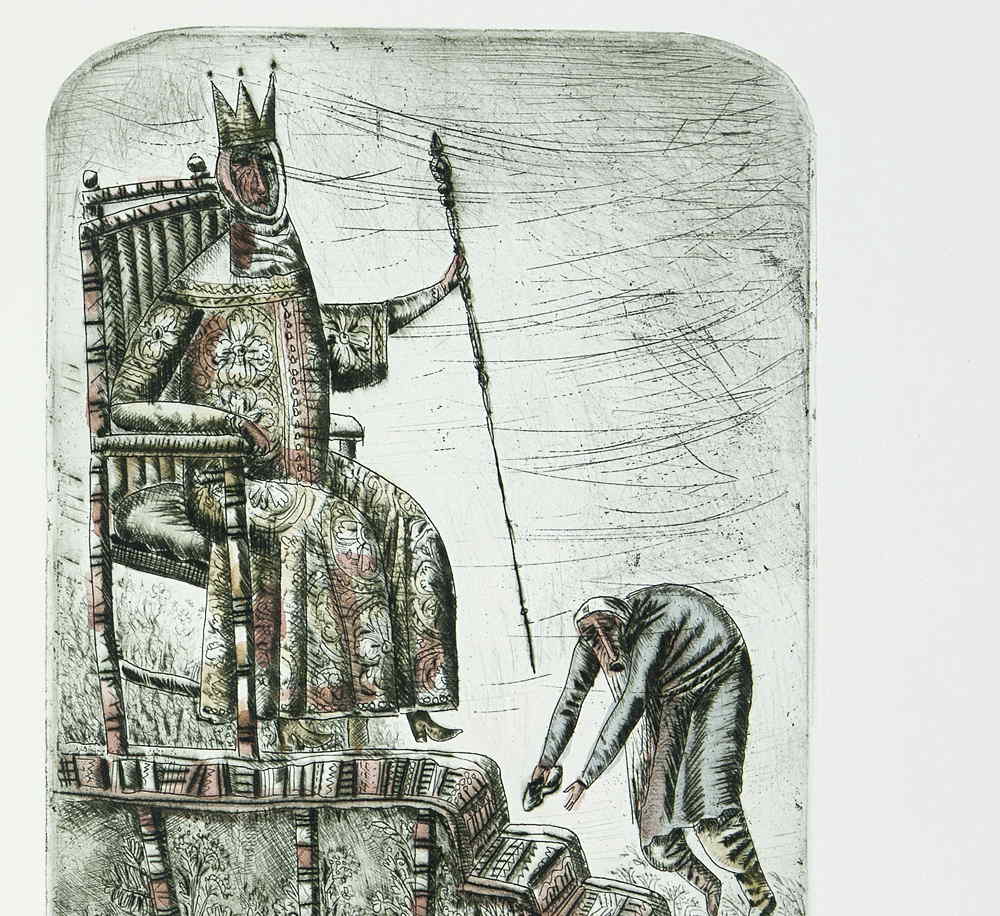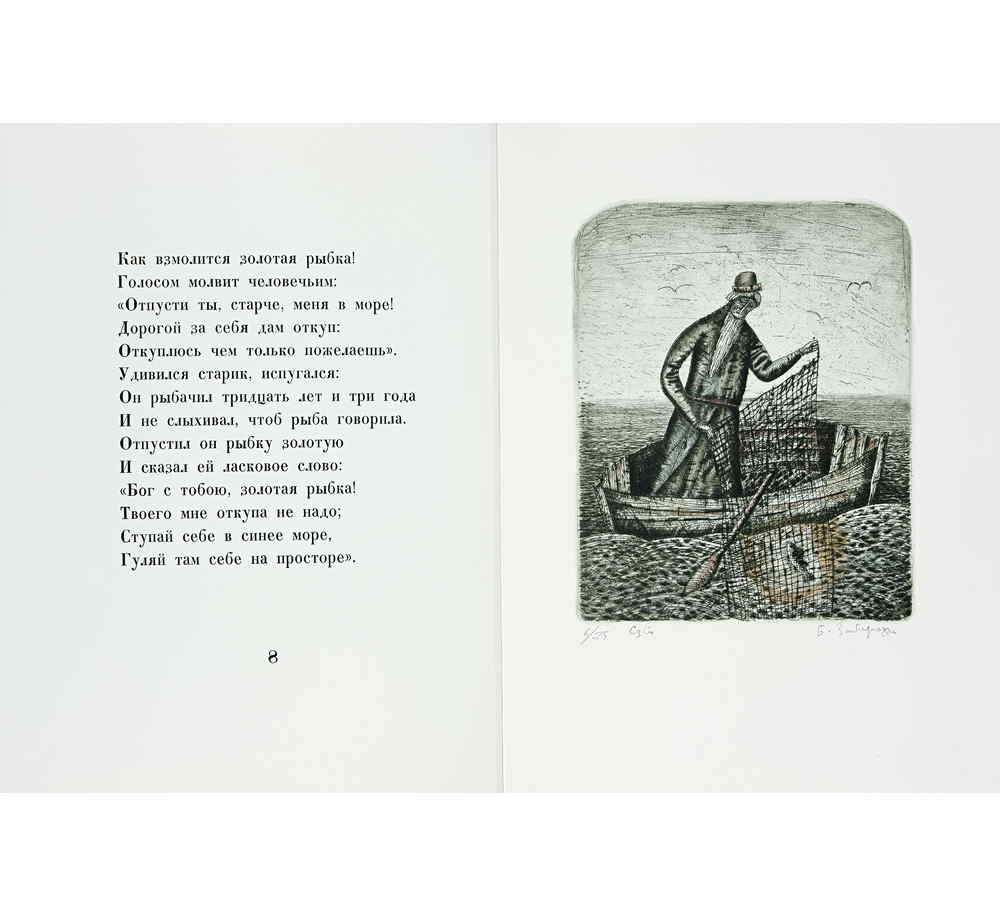THE TALE OF THE FISHERMAN AND THE FISH
Short description:
Artists:
Edition:
25 copies numbered and signed by the publisher and the artist. Copy № 6 is in the collection of the State Hermitage.
Additional information
Details of the creation of this masterpiece
-
Year of publication:2002
-
Number of pages:92
-
Dimensions:310 × 240 mm
-
Paper:Tumba Grafik «Zorn» (Sweden), 300 g/m², handmade; Hahnemühle (Germany), 300 g/m², handmade
Language:
Russian
Alexander Pushkin’s fairy tale is a remarkable example of archetypical Russian consciousness that presents many key ideas and problematic situations that each one of us will face. This story shows the nature and character of self-interested people who will always desire and pursue something more than they have and can have. They have no sense of moderation or the limit of their capabilities. They fall prey to passions, to the desire for power and wealth, to envy, malevolence and greed. In Russian culture “to be left with a broken trough” has become a fixed expression conveying the end result of the old woman’s avarice and selfishness, on the one hand, and of the old man’s weak character, submissiveness and lack of willpower, on the other.
Work on this edition of The Tale of the Fisherman and the Fish began in the year 2000. The first copy of the book came out in 2002.
Work on this edition of The Tale of the Fisherman and the Fish began in the year 2000. The first copy of the book came out in 2002.

The text of the tale was typeset by hand in the Elizavetinskaya typeface and printed on a 19th-century Dingler hand press.
The book contains 10 illustrations masterfully executed by the artist Boris Zabirokhin in the dry-point technique. In copies 1–7, the artist himself tinted the prints by hand. Copies 8–25 contain monochrome prints. The pictures are poetic and metaphorical in content, imbued with a special warmth, charm, folkloric melodiousness and naive romanticism.
The book contains 10 illustrations masterfully executed by the artist Boris Zabirokhin in the dry-point technique. In copies 1–7, the artist himself tinted the prints by hand. Copies 8–25 contain monochrome prints. The pictures are poetic and metaphorical in content, imbued with a special warmth, charm, folkloric melodiousness and naive romanticism.

The cover of the book is made of fish leather and papyrus. The book has a storage case decorated with fabric.
Participants in the work on this publication:
Creators of the illustrations, layout, printing of the engravings — Boris Zabirokhin
Design of the cover — Piotr Suspitsyn
Hand typesetting and printing of the text — Sergei Yashin
Binding work — Andrei Degtev, Konstantin Svetlov
Participants in the work on this publication:
Creators of the illustrations, layout, printing of the engravings — Boris Zabirokhin
Design of the cover — Piotr Suspitsyn
Hand typesetting and printing of the text — Sergei Yashin
Binding work — Andrei Degtev, Konstantin Svetlov

Additional information
Details of the creation of this masterpiece
About this edition
About this edition:
-
Year of publication:2002
-
Number of pages:92
-
Dimensions:310 × 240 mm
-
Paper:Tumba Grafik «Zorn» (Sweden), 300 g/m², handmade; Hahnemühle (Germany), 300 g/m², handmade
Language:
Russian
Alexander Pushkin’s fairy tale is a remarkable example of archetypical Russian consciousness that presents many key ideas and problematic situations that each one of us will face. This story shows the nature and character of self-interested people who will always desire and pursue something more than they have and can have. They have no sense of moderation or the limit of their capabilities. They fall prey to passions, to the desire for power and wealth, to envy, malevolence and greed. In Russian culture “to be left with a broken trough” has become a fixed expression conveying the end result of the old woman’s avarice and selfishness, on the one hand, and of the old man’s weak character, submissiveness and lack of willpower, on the other.
Work on this edition of The Tale of the Fisherman and the Fish began in the year 2000. The first copy of the book came out in 2002.
Work on this edition of The Tale of the Fisherman and the Fish began in the year 2000. The first copy of the book came out in 2002.

The text of the tale was typeset by hand in the Elizavetinskaya typeface and printed on a 19th-century Dingler hand press.
The book contains 10 illustrations masterfully executed by the artist Boris Zabirokhin in the dry-point technique. In copies 1–7, the artist himself tinted the prints by hand. Copies 8–25 contain monochrome prints. The pictures are poetic and metaphorical in content, imbued with a special warmth, charm, folkloric melodiousness and naive romanticism.
The book contains 10 illustrations masterfully executed by the artist Boris Zabirokhin in the dry-point technique. In copies 1–7, the artist himself tinted the prints by hand. Copies 8–25 contain monochrome prints. The pictures are poetic and metaphorical in content, imbued with a special warmth, charm, folkloric melodiousness and naive romanticism.

The cover of the book is made of fish leather and papyrus. The book has a storage case decorated with fabric.
Participants in the work on this publication:
Creators of the illustrations, layout, printing of the engravings — Boris Zabirokhin
Design of the cover — Piotr Suspitsyn
Hand typesetting and printing of the text — Sergei Yashin
Binding work — Andrei Degtev, Konstantin Svetlov
Participants in the work on this publication:
Creators of the illustrations, layout, printing of the engravings — Boris Zabirokhin
Design of the cover — Piotr Suspitsyn
Hand typesetting and printing of the text — Sergei Yashin
Binding work — Andrei Degtev, Konstantin Svetlov

Alexander Pushkin
THE TALE OF THE FISHERMAN AND THE FISH
An edifying tale from the great Russian writer
Download presentation










